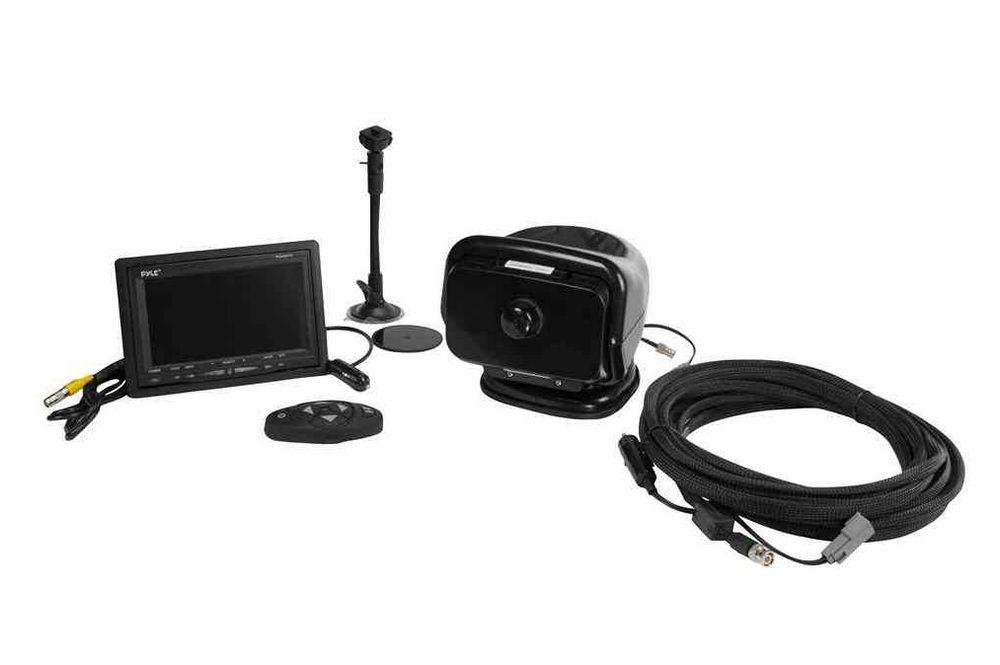Magnetic Helios Thermal Imaging Camera System -6" LCD Monitor Wireless Remote -12VDC -Black
Magnetic Helios Thermal Imaging Camera System -6" LCD Monitor Wireless Remote -12VDC -Black
Sold by: LARSON ELECTRONICS
The GL-3351-M Magnetic Mount Remote Controlled Thermal Imaging Infrared Camera system with a 6 inch LCD monitor is a small thermal sensing camera mounted in a remote controlled frame that can detect heat differentials between 32°- 240° F. The remote controlled thermal imaging camera has a 1500` detecting range, a field of view that measures 35° horizonatly by 27° vertically, and can rotate 370° with a 135° tilt. It also comes in two speeds, fast and slow (turtle and hare). The infrared camera has sensor type of 320 x 240 uncooled micro bolometer.
The LCD monitor is supported by a flexible neck and can be mounted to a dashboard or a window with its suction cup base, or mounted anywhere else with simple installation. With this particular unit, the white color indicates a hot substance, whereas the black color indicates a cold subject.
The remote controlled thermal imaging infrared camera system with 6 inch LCD monitor is available with wireless or wired remote controls. The wireless versions are available with radio based handheld or dash mount remote controller. Both controller choices offer left, right, up and down motor control as well as fast and slow motor speed control. The operator can also turn the camera on and off from the controller.
The remote controlled, pan/tilt thermal imaging camera also comes equipped with an internal core heater that prevents the lens of the camera from icing up. Due to it`s high resolution camera, this thermal imaging camera can display images up to 1,500 feet in any direction that it is pointed, through fog, smoke and precipitation.
The remote control camera is magnetically mounted. The magnet is water tight and has a 100 pound grip base and is tested to 60 mph. The magnetic base is encapsulated in soft rubber to adapt to uneven vehice surfaces and prevent scratches on vehicle paint. A wrap around base seal prevents dirt from entering the base of the light.
The Remote Controlled Thermal Imaging Infrared Camera runs off 12 VDC and has a frequency of 30 hertz. It is equipped with a 16 foot, outdoor rated cord with a cigarette plug. Weather tight connector enables operators to disconnect cord at 12 inches from the light for storage or vehicle portability. Larson Electronics offers an alternative 24V DC setup for military applications. At 6.75" L x 7.25" W x 8" D and weighing only 4lbs, the thermal imaging camera can be mounted practically anywhere from cars to trailers. The thermal camera comes with various options including color and wireless/wired remote setup.
Heated objects are displayed as white hot on the LCD screen.
|
|||||||||||||
Shipping and delivery Information
Shipping and delivery Information
Estimated delivery times range from same day to 2 weeks, depending on your location, the product ordered and stock availability. External factors such as courier network disruptions can also impact delivery timelines. PuriLite strives to ship your purchase in the shortest possible time using industry standard courier services.
For any questions related to shipping and delivery, please call +1-647-254-9757, email us at info@purilite.ca or chat with us by clicking on the chat icon at the bottom right of this page.
The PuriLite Peace of Mind 30-day money back guarantee
The PuriLite Peace of Mind 30-day money back guarantee
Enjoy our peace of mind 30-day money back guarantee on all products. If you are not satisfied with any of our products, your item is eligible for return within 30 days of purchase, subject to the terms & conditions below.
1. Goods must be returned in new & unused conditions with all original packaging. Do not write or put stickers on original packaging.
2. Any shipping charges incurred by Purilite to ship the product to your destination and returns from your location to our warehouse, in case of refused shipments, are non-refundable.
3. Depending on the product purchased, the client will be responsible for shipping product back to our warehouses.
4. Restocking fees map apply once inspected at our warehouse. All credits are subject to final inspection of good upon arrival at our destination.
5. Defective products are eligible for return.
If you purchased a product and did not receive the parcel, please contact us at sales@purilite.ca and we would be happy to assist you right away! PuriLite uses secure and well-established carriers (such as Canada Post, FedEx, Purolator, UPS etc.) to ensure your purchase is delivered successfully to your doorstep. All items are delivered with a tracking ID and are traceable. If your parcel was indeed not received, we will issue back a 100% refund.
Shop with confidence knowing that your purchase is protected, and your peace of mind is our commitment. Thank you for choosing PuriLite!
Sustainability & Ethical Sourcing
Sustainability & Ethical Sourcing
At PuriLite, we believe innovation should go hand-in-hand with responsibility. That’s why we’re committed to creating products that not only perform well but are also thoughtfully made with the planet and people in mind.
♻️ Sustainable Practices
- We prioritize durable materials that extend the product life cycle and reduce waste.
- Where possible, our packaging is made from recyclable or minimal-waste materials, helping to reduce environmental impact.
- Many of our electronic products are designed with energy efficiency in mind to minimize power consumption.
🤝 Ethical Sourcing
- We partner with manufacturers who fillow fair labor practices, ensuring safe working conditions and fair wages for their workers.
- All suppliers are carefully vetted for compliance with environmental and ethical standards.
- We avoid the use of materials from conflict zones and work to reduce the environmental footprint across our supply chain.
🌍 Our Ongoing Commitment
We're actively exploring new ways to improve—from using eco-certified components to optimizing our logistics for a lower carbon footprint. Every small step counts, and we’re committed to doing our part in building a more sustainable future.


